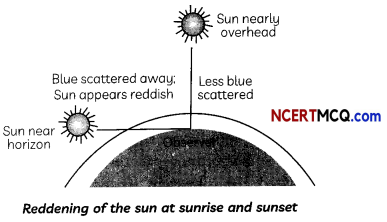Scattering of Light:
The phenomenon of change in the direction of light on striking an obstacle like an atom, a molecule, dust particle, water droplet etc is known as scattering of Light. It involves bouncing off electromagnetic radiation by atoms/molecules of the medium through which they are travelling.
Tyndall Effect
Tyndall effect deals with the phenomenon of scattering of light by colloidal particles.
- When a fine beam of sunlight enters a room, the particles present in the room become visible due to the scattering of light by these particles.
- When sunlight passes through a canopy of a dense forest, tiny water droplets in the mist scatter light.
The colour of the scattered light depends on the size of the scattering particle. Very fine particles scatter mainly blue light while particles of Larger size scatter light of Longer wavelength. If the size of the scattering particle is large enough, then the scattered light may even appear white.
![]()
Blue Colour of Sky
The blue colour of the sky is due to the scattering of light by the large numbers of molecules present in the earth’s atmosphere. As the size of the scatterer is much smaller than the wavelength of light, light of a smaller wavelength is scattered the most. If the earth had no atmosphere, the sky would appear black in the day time as no colour of sunlight would be scattered then.
White Colour of Clouds
Clouds are visible to us due to scattering of light from lower parts of earth’s atmosphere which contains dust particles, water droplets, ice particles etc. As the size of the scatterer is much larger than the wavelength, all wavelengths are scattered nearly equally, due to which clouds appear generally white.
Sun Looks Reddish at Sunrise and Sunset
At the time of sunrise and sunset, the sun is near the horizon due to which sunrays have to travel much larger part of the atmosphere. Most of the blue light is thus scattered away. The red colour having the longest wavelength is scattered the least and hence enters our eyes. When the sun is nearly overhead, the sunlight has to pass through much smaller portion of earth’s atmosphere due to which scattering is much less and the sun looks white.
